Most of us, when we head out into the country, gravitate to the paths that criss-cross our land.
Our eye is instinctively drawn to those little green dotted lines on the map, knowing that the route is likely to present less of a challenge than striking out across unbroken moorland terrain, or risking the wrath of an irate farmer by trespassing on private land.
But how did those paths come into being? Why are they where they are, and who was responsible for establishing the network of rights of way that we now use?
England alone has 190,000 km (118,000 miles) of such routes, ranging from mountain footpaths to byways that have to be shared with adventurous motorists.
Often we will give barely a thought to the thousands of feet, and hooves, that have trodden the path before us.
Writers Nicholas Rudd-Jones and David Stewart, accompanied sometimes by a small dog called Brough, set out to trace the history of Britain’s walking routes, and the result is Pathways, a collection of 20 walks along ways ranging from Roman roads to modern pedestrian precincts.
The authors describe themselves as ‘footpath fanatics’ and chart the transition from the routes used through necessity to the present-day popularity of leisure walking.
The writers explain, though, that the latter is not a modern invention; even the Romans took leisurely promenades through private gardens. However, the tales of most early walkers went untold, and the pair attempt to get to the bottom of why Britain’s paths are where they are.
The book is arranged mostly chronologically, starting with the ancient ridgeways and processional routes to burial sites, moving through Roman routes, wetland tracks, monks’ trods, pilgrims’ ways and on to corpse roads.
These last paths were often deliberately routed through the worst bogs by landowners anxious not to halt the progress of pallbearers to churches in neighbouring valleys but equally unwilling to make them too easy to walk by the general public, lest they became established rights of way.
Packhorse routes then developed – the ‘motorways’ of the late middle ages and early industrial age, carrying goods between emerging towns and cities.
Drovers, the cowboys of their age, with the swagger to go with it, established their own routes, often marked by three Scots pines where an overnight stop could be made.
Village paths joined settlements and were long protected by law until the Enclosure Acts between the mid 18th and mid 19th centuries severely curtailed access to the countryside, which was only slowly restored in the 20th century.
Now, virtually all the old paths are used principally for leisure, and the format of this full-colour book is to give a description of the historical background of each type of path, then a detailed route description of an example, along with a personal account of a walk along the route.
There are schematic maps, and all the walks in the 320-page book will also be downloadable from the Walking World website, for which a subscription is payable.
There are also other examples of the path types, and suggestions for further reading.
Pathways gives a good insight for walkers who want to know a little more about the origins of the routes they travel, and has a geographical spread from north-west Scotland to Snowdonia, from the Yorkshire Dales to Snowdonia, and even the City of London.
There is a howler in a Scottish chapter where Glencoe’s great shepherd is described as Buachaille Etive Moor, and everyone will be able to come up with a ‘why didn’t they include so-and-so’ instances, but in a book covering such a breadth of path types, the authors have chosen a good variety of examples. Anyone reading the book will be armed with more knowledge on their next expedition into the British countryside, be it following in the footsteps of the Cistercian monks or the wild and burly cattle drovers.
Pathways, by David Stewart and Nicholas Rudd-Jones is published by Guardian Books and retails at £20.
grough readers can snap up a copy for just £12, a saving of £8 on the normal retail price. Visit the Guardian Bookshop online and key in the promotion code GROUGH06. The same code can be used on the telephone order line 0330 333 6846.
This offer runs from Monday 13 June until Monday 11 July 2011.
Or, for your chance to win a free copy of Pathways, visit our competition page.
